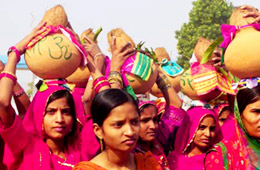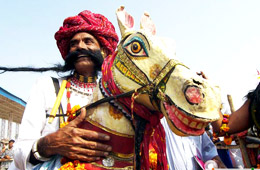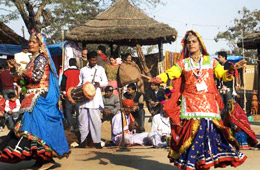|
 Festivals are the very essence of life for the people of
Rajasthan. Every season is marked with a series of fairs and
festivals except the summer months when the blazing sun scorches the
earth. With the arrival of the monsoons the festival season is
unleashed. And the most important festival to herald the monsoons is
the Teej – reflecting the magic of the rainy season.
Festivals are the very essence of life for the people of
Rajasthan. Every season is marked with a series of fairs and
festivals except the summer months when the blazing sun scorches the
earth. With the arrival of the monsoons the festival season is
unleashed. And the most important festival to herald the monsoons is
the Teej – reflecting the magic of the rainy season.
The arrival of monsoons
is a time for celebration. The parched land, scorched by the blazing
summer sun, gets bathed in the first showers. The depressing
landscape, a morbid brown is spontaneously transformed. An
intoxicating fragrance of rain soaked sand fills the atmosphere
clearing the cloud of dust that veils the sky in the preceding
months. The brown is overtaken by a vibrant green. A cool breeze
revives the spirit of the people of the desert state of Rajasthan.
Peacocks dance in
ecstasy, women rejoice by putting up rope swings in the garden and
lilting melodies can be heard heralding the festival of Teej
celebrated on the third day of the waxing moon in the month of Sawan
(July –August). The festival of Teej reflects the magic of the
monsoon. It is the beginning of a series of fairs and festivals,
which are celebrated throughout the autumn and winter months
culminating in the spring festival of Gangaur. According to a local
saying Teej is the key to open the lock of festivals locked away for
the summer by the spring festival of the erstwhile Jaipur royal
state. The old tradition still continues. While Gangaur is celebrated
in different ways in each region, the celebration of Teej remains
exclusive to the Jaipur region.
 Teej is essentially a
women’s festival. On this day goddess Parvati was united with
Lord Shiva after a penance of a hundred years – making them a
symbol of an ideal marriage. Invocation of Parvati’s blessings
on this day results in continued marital bliss. Women dress up in all
their finery to worship the goddess. Girls engaged to be married
receive gifts from their future in-laws a day before the festival.
The gift called shrinjhara derived from the word Shringar (adornment)
consists of henna, lac bangles, a special dress of laharia (tie and
dye fabric) and a sweet called ghewar. Teej is essentially a
women’s festival. On this day goddess Parvati was united with
Lord Shiva after a penance of a hundred years – making them a
symbol of an ideal marriage. Invocation of Parvati’s blessings
on this day results in continued marital bliss. Women dress up in all
their finery to worship the goddess. Girls engaged to be married
receive gifts from their future in-laws a day before the festival.
The gift called shrinjhara derived from the word Shringar (adornment)
consists of henna, lac bangles, a special dress of laharia (tie and
dye fabric) and a sweet called ghewar.
Laharia and ghewar are
traditionally associated with Teej. Days before the festival main
markets in the walled city of Jaipur wear a festive look where the
textile shops stock a wide range of laharia. For the women of the
noble families a special variety of laharia in pastel shade of blue
called samandar (sea) has been created. Sweetshops do brisk business
in ghewars. Rich families living outside Rajasthan order their ghewar
to be flown out from Jaipur.
Young women can be seen
getting the palms of their hands decorated with henna- special motifs
to match the mood of Teej are applied – for these also the most
popular are known as ghewar and laharia. Lilting songs –
specific to the festival are sung to accompany the application of
henna creating an aura of romance. The colour of the henna symbolises
the intensity of the beloved’s love for the woman.
During the time of the
princely rule the royal image of Parvati referred to as Teej Mata,
was taken out for two days in a ceremonial procession. Now after the
merger of the state, the image is still taken out in procession
organised by the Sawai Man Singh II Museum Trust and the Rajasthan
Tourism.
A few days before the
festival the image is repainted and on the day of Teej is bedecked in
a new dress and traditional jewellery and worshipped in the Zenana
(the ladies’ chamber in the City Palace) by the woman of the
royal family. After the ritual is over, the image is brought out into
the courtyard to join the procession. Thousands of spectators wait
anxiously to catch a glimpse of the goddess. The strength of the
crowd depends on the strength of the monsoon crowd of colourfully
dressed villagers gathers on the terrances on both sides of the road.
A young village girl
dreams of being in Jaipur for Teej and a man who wants to win her
heart must make her dream come true. Hundreds of couples come to the
city, singing and dancing, on bullock carts, camel carts, and open
tractor-trailers. They ramble through the city buying knick-knacks
and savouring the food. By the afternoon the crowds begin to gather
on the terraces in a bid to get a vantage viewpoint.
At the auspicious moment
decided by the priest, the procession is led out by the Nishan-ka-
hathi (the elephant with the flag). The magnificent procession of
caparisoned elephants, bullock carts, and chariots comes out of the
Tripolia Gate. And then the much-awaited image of Teej Mata appears,
mounted on the traditional palanquin- Takht-e-rawan. The crowd surges
to catch a glimpse of the deity and a shiver of excitement pass
through he audience. As the procession moves out of vision, people
start dispersing, returning to their villages waiting for another
festival.
Rajasthan has a festival for every
season but Teej holds a special place as a time for rejuvenation and
revival of spirits. Teej is made an even more memorable experience if
it rains on this day. People pray for a cool shower at the time of
the procession – for a Teej without rain is like a Christmas
without snow.
|